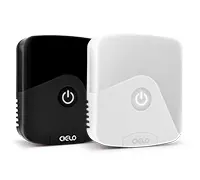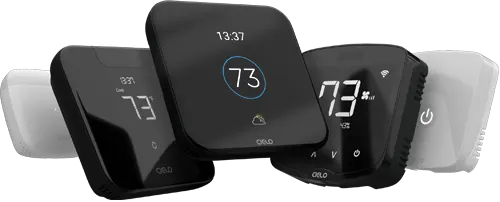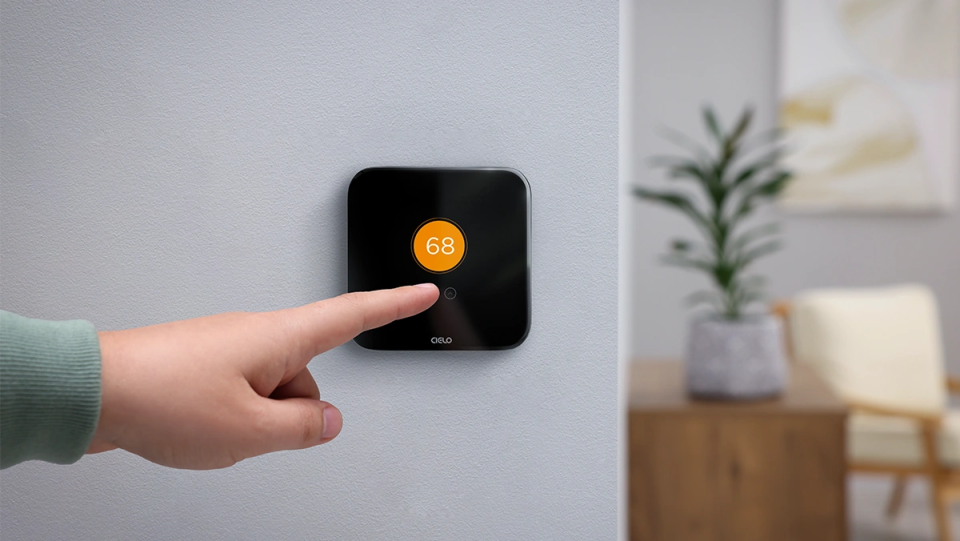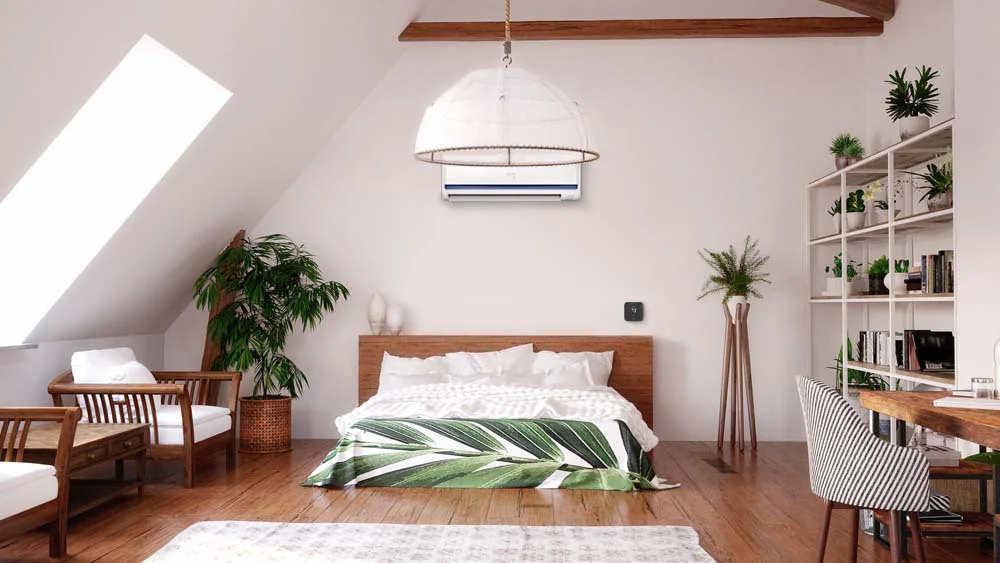
Key Takeaways
- An attic air conditioner helps maintain a comfortable environment and protects your roof from damage.
- Opt for a ductless attic air conditioner for easy installation and better efficiency without the need for ductwork.
- Proper insulation in the attic prevents cool air from escaping, helping your AC run more efficiently.
Turning an attic into a comfortable residential space (such as a bedroom, home office, or hobby studio) may sound like a tempting idea, but a major potential stumbling block is how to keep the attic cool.
The attic experiences higher temperatures than the rest of the house and is more prone to moisture buildup due to inadequate ventilation and insulation. This encourages mold growth and exacerbates roof damage, along with other issues.
The solution? An attic air conditioner.
Whether you’re remodeling your attic or trying to fix a hot upper floor, this guide will help you find the best attic air conditioning solution for your space, comfort, and budget.
Why Do You Need an Air Conditioner in the Attic?
Converting an attic into a home office, guest bedroom, or studio can increase the amount of usable living space in a house. However, without proper modifications, the attic space may be impractical for regular use.
Here’s how installing an attic air conditioner can help:
- Attics trap heat more than any other part of the home, especially during summer. An air conditioner helps maintain a steady, livable temperature, allowing your attic to be used comfortably every day.
- Enclosed attic spaces can collect warm, moist air, resulting in high humidity and an increased risk of mold growth. Since air conditioners naturally remove moisture as they cool, they help maintain ideal humidity levels and improve indoor air quality.
- A hot attic acts like a giant radiator, transferring the warmth to the lower levels. Cooling the attic can reduce the heat load on your central HVAC system, making it easier to cool your entire house and potentially lowering energy bills.
- Excess heat and moisture buildup in the attic can shorten the lifespan of your roof structure. An attic AC system helps regulate the temperature and moisture, preserving both your home’s structure and indoor comfort.
Factors to Consider When Buying an Attic Air Conditioner
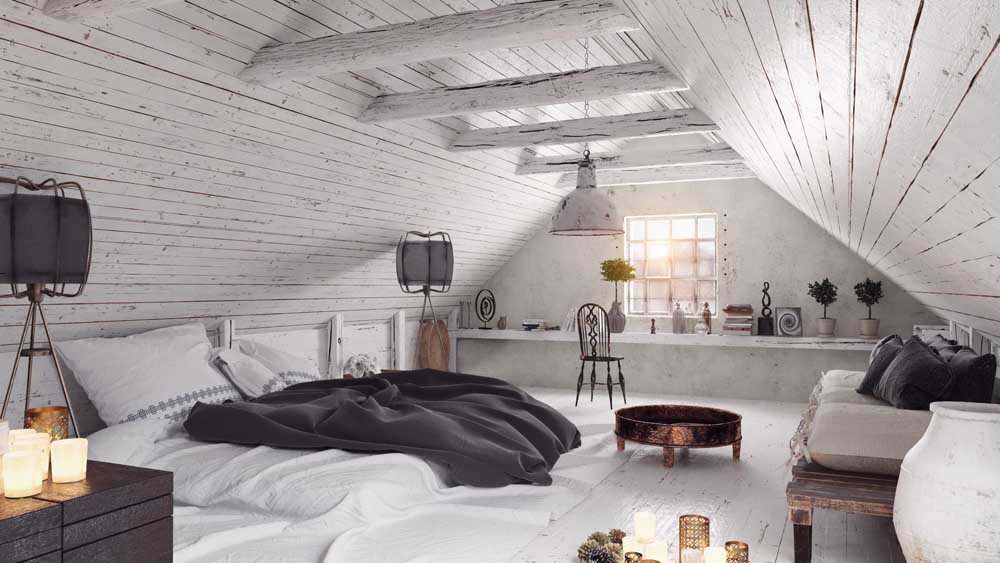
To help you choose the perfect attic air conditioner, consider the following key factors before making a purchase.
1. Attic Insulation & Air Sealing
Before installing an AC in your attic, ensure there are no uninsulated spaces. If your attic is uninsulated, there is no point in conditioning it because you’ll end up losing all the cooled air. The air conditioner in your attic already has to work harder than a regular room AC to cool the hot air. In such a case, a lack of insulation will further decrease the efficiency of your AC unit.
Here’s how to insulate your attic space.
2. Ease of Installation
Depending upon your attic space, choose an air conditioner that fits well and is easy to install. For example, installing a window air conditioner for an attic with small roof windows would be extremely difficult. Similarly, portable units won’t be suitable for small attics since they take up floor space. Secondly, if you are on a budget, consider opting for a DIY-friendly AC to save installation costs.
3. Air Conditioner Sizing
Moving further, it is of utmost importance to purchase an adequately sized AC unit for the attic. 20 British Thermal Units (BTUs) per square foot is sufficient for a regular indoor space, but attics are different. These spaces trap heat from the home and catch sunlight from above. That is how they end up extremely hot during the summer.
|
Space Size (sq ft) |
Regular BTU Recommendation |
Attic BTU Recommendation |
|
400 |
8,000 |
10,000+ |
|
600 |
12,000 |
15,000+ |
|
800 |
16,000 |
18,000+ |
Explore this comprehensive guide on air conditioner sizing.
5. Energy Efficiency
Energy efficiency in air conditioners is measured by SEER and EER ratings.
SEER measures the total cooling output over an entire cooling season, divided by the total energy consumed. EER measures how efficiently an air conditioner cools a space relative to the electrical energy it consumes. It is calculated by dividing the cooling output (in BTUs) by the power input (in watts).
The higher the EER or SEER rating, the more energy-efficient the unit, leading to lower energy bills in the long term.
6. Durability
Always keep the durability factor in view while buying an attic AC unit. For example, a good mini-split can last you for 15 to 20 years. On the other hand, a portable AC might be more convenient and less expensive, but won’t last more than 7 to 10 years.
7. Know the Local Building Codes
In many areas, attic AC installations must comply with local building codes, especially for electrical capacity & circuit load, fire safety clearances, & wall/roof penetrations for venting or drainage.
Failing to comply with the code can result in fines, insurance issues, or reinstallation costs. Always check with a licensed contractor or your local municipality before beginning the installation.
Types of Air Conditioners Suitable for Attic Installation
The attic is arguably one of the most temperature-sensitive areas in a household setting. These peculiar features, such as slanting roofs and restricted wall space, make it a crucial decision to choose the right air conditioning unit. Not every AC unit offers an ideal solution to this challenging situation.
Let’s get into the details of the most common AC types suitable for attic use, along with their pros, cons, and installation considerations.
-
Mini-Split Unit

Mini-split AC units are your best choice for the attic. These AC units are reliable and energy-efficient. Since their noisy part (compressor) is installed outside your space, they work quietly.
Although these attic AC units are a bit on the pricier side, their durability, quiet operation, easy installation, and energy efficiency make them the best choice.
|
Pros |
Cons |
|
Highly energy-efficient |
Higher upfront cost than window or portable units |
|
Quiet operation |
|
|
Provides both heating and cooling in case of mini-split heat pumps |
-
Window Air Conditioner
Window ACs are a relatively economical way to cool small areas of the attic. They usually have better energy performance ratios compared to portable types, but they are not as efficient as mini-splits. When opting for window AC, make sure you have a big enough window to install this type of AC. It becomes nearly impossible to install attic air conditioners on narrow or inclined windows. Here’s everything you need to know about installing window ACs.
|
Pros |
Cons |
|
DIY installation |
Blocks natural light and reduces window accessibility. |
|
Lower upfront cost |
Noisy operation. |
-
Portable Air Conditioner
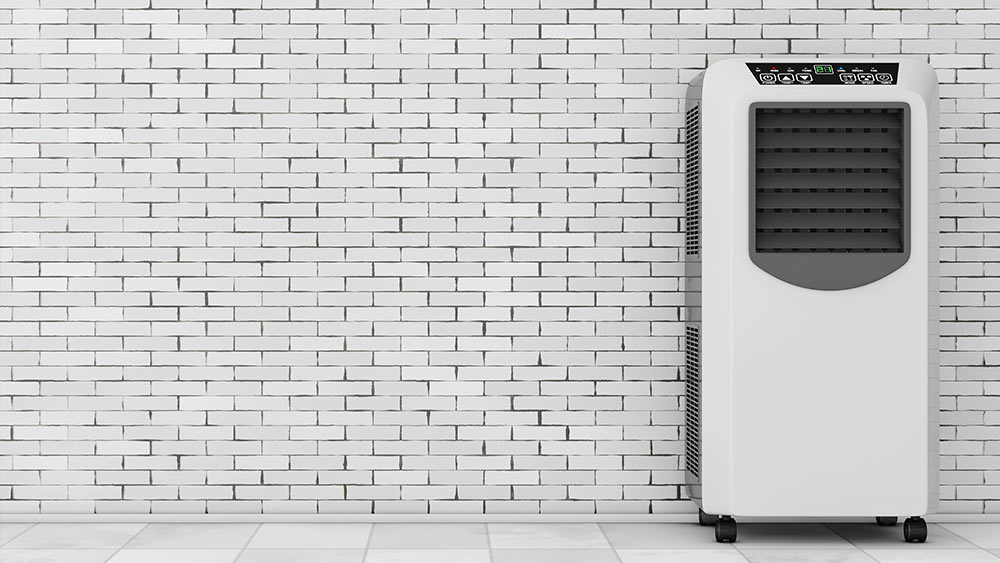
Portable units are popular because they can be moved around easily but also take up a good chunk of floor space. These units come with either one or two hoses that need to be vented out through a window or a wall. This is essential to expel hot air outside and properly cool your attic. Attaching a hose can be tricky at times, depending on the size of your attic window and where it is located. However, if your window is easily accessible, then the entire process is made simple by a window kit that normally comes with portable AC units.
|
Pros |
Cons |
|
Can be moved to different rooms as needed. |
Occupies floor space, which is often limited in attics. |
|
No permanent installation or structural modifications required. |
Less energy-efficient |
|
Good temporary cooling option for occasional attic use. |
Noisy operation |
-
Through-the-Wall Air Conditioner
These air conditioners are called through-the-wall ACs because they are installed by drilling a large hole in the wall. In the case of attics, carving this hole can be quite challenging. Moreover, they are big in size, so they do not look aesthetically pleasing. Apart from the installation problem and aesthetics, there is not much you can complain about. These air conditioners are not as expensive as portable or mini-split AC. Another upside is that they are quite efficient, second only to mini-splits in that regard.
|
Pros |
Cons |
|
More energy-efficient than window and portable AC units. |
Larger and bulkier, which can affect the attic’s aesthetic appeal. |
|
Frees up window space, allowing natural light and ventilation. |
Automate Your Attic Climate With Smart Temperature Controls

You can increase the efficiency of your attic air conditioner by pairing it with a smart thermostat for ductless units. It helps you automate your attic climate and allows you to adjust settings from anywhere using your phone. The biggest perk is enjoying the perfect temperature and humidity levels while also saving money on bills.
With Cielo Breez Max, you can set intelligent temperature or humidity triggers to maintain a comfortable climate. Moreover, you can set weekly schedules as per your routine. If you use your attic as an office, you can set a schedule to turn your AC on for your work hours and then turn it off for the rest of the day.
Attic AC units sometimes get neglected, and a lack of maintenance can lead to a decline in the unit’s performance. Cielo Breez mini-split thermostats provide regular AC air filter alerts so that you can clean your AC air filters on time.
Your best choice to make any mini-split, window,
or portable AC smart. Enhance your comfort and savings.

Attic Air Conditioner Problems: How to Deal With Them?
If your attic AC unit is not cooling as it should, several reasons may be to blame for this issue.
-
Lack of Insulation
The first and biggest problem can be air leaks because of a lack of insulation. So, find the air leaks and insulate your attic properly to keep the conditioned air inside and avoid leakage.There are different insulation types available, like foam board insulation, spray foam insulation, or radiant and reflective insulation. Foam board and blanket insulation are better for unfinished ceilings and walls, whereas spray foam or loose-fill insulation will be better for hard-to-reach corners.
-
Incorrect AC Size
Another reason an attic air conditioner fails to cool the space well is the air conditioner’s size. An air conditioner needs more BTUs to cool an attic than a standard room of the same size. A unit too small for the space will need much more time and will struggle to maintain a comfortable environment.
-
Lack of Air Circulation
For a large or segmented attic, a lack of air circulation might be the culprit. You can use a fan in addition to your attic AC to solve this problem. Fans do not cool or heat a space on their own, but they are great for enhancing air circulation in an area. Fans help keep the air moving in your attic and avoid hot and cold spots.
-
Clogged Drain Pipes
If your AC unit is leaking water in the attic, it could be because of a clogged drain line or a dirty air filter. Cleaning your drain pipes and AC filter will solve the problem. If the issue remains unresolved, it is better to contact a professional.
In Conclusion
An attic air conditioner is something you cannot do without if you plan on using your attic as a livable space. Therefore, you can install a mini-split, portable, or window air conditioner to meet your cooling requirements. However, you must consider the BTUs, energy efficiency, durability, and comfort before deciding on one device. Don’t forget to pair it with a smart mini-split thermostat like Cielo Breez for added convenience.
Frequently Asked Questions
What’s the Best Air Conditioner for Attic Bedrooms or Offices?
For attic bedrooms or home offices, you want comfort without bulky units taking up space. A ductless air conditioner, such as a mini-split system, is typically the best choice. It’s quiet, efficient, and doesn’t need ductwork, making it perfect for converted living spaces.
Should You Opt for Ductless Heat Pumps in Attics?
Heat pumps provide both heating and cooling, making them ideal for converting attics into year-round living areas like offices or guest rooms. This helps eliminate the need to install two different units to heat/cool your attic.
How Does an Attic Air Conditioner Help Improve the Efficiency of My Central HVAC System?
An attic air conditioner helps by reducing the high temperatures in the attic. This prevents heat from transferring into the lower levels of your home, easing the workload on your central HVAC system. As a result, your system runs more efficiently, lowers energy bills, and keeps your home more consistently comfortable.


